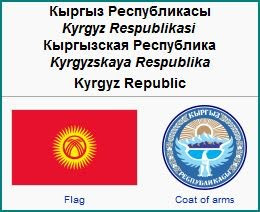Here we take a look behind the headlines to see what is really going on.
At the end of the first post, I pointed out that the unrest was supposedly sparked by rival gangs.
Well, we now consider Kyrgyz South and Uzbek issue, dated June 9, 2010, by Sanobar Shermatova. The English is a little hard to decipher, since it is not the author's native language, so instead of quotes, I summarize.
Aibek Mirsidikov, known as "Black Aibek", was reputedly an organized crime boss. Government authorities recently announced that organized crime factions were becoming more active in southern Kyrgyzstan (which borders neighboring Uzbekistan in the Ferghana Valley, near the city of Osh); it appeared a mob war was breaking out.
When Black Aibek was murdered, the governor of Jalal-abad Oblast (the province north of Osh Province, where the city of Osh is located, and where the recent unrest has been occurring), Bektur Asanov, blamed the death on the mob war.
In Kyrgyzstan, the business and criminal worlds are closely linked, and organized crime provides important "services" to political factions in return for certain payments. Once the services are rendered, if the payment is not made on time, trouble ensues. A classic example of this was when the organized crime boss Ryspek Akmatbaev threatened to bombard the Kyrgyz White House if the previous president, Kurmanbek Bakiev (run out of Kyrgyzstan during violence this past April), did not pay what he owed to the underworld. It was scandalous as the people of Kyrgyzstan saw their president negotiating with a crime boss.
Black Aibek was an Uzbek. Another Uzbek, Kadyrzhan Batyrov, who is reputed to be a legitimate businessman with significant political clout, emerged as another popular leader in the community. Supposedly, Batyrov was losing power under exiled President Bakiev's regime, which was more closely tied to illegal business activities; when Bakiev left recently, Roza Otunbayeva became the interim president, and the situation began to reverse. So, in retaliation, Black Aibek blamed Batyrov for burning the houses of the ex-president and his relatives; these allegations of Kyrgyz suffering violence at the hands of Uzbeks had the anticipated incendiary effect, igniting the most recent round of ethnic violence.
The unrest that resulted in Bakiev's departure and Otunbayeva's accession to the interim presidency has, of course, been blamed on Russian intelligence and the CIA, depending upon who you listen to.
An excellent article by STRATFOR blames it on Moscow, with excellent analysis of the rationale that would lead to the Kremlin's involvement. I present here only an excerpt, and very highly recommend that you read the article, Kyrgyzstan and the Russian Resurgence, in its entirety.
Central Asia largely comprises a massive steppe of more than a million square miles, making the region easy to invade. The one major geographic feature other than the steppe are the Tien Shan mountains, a range that divides Central Asia from South Asia and China. Nestled within these mountains is the Fergana Valley, home to most of Central Asia's population due to its arable land and the protection afforded by the mountains. The Fergana Valley is the core of Central Asia.
To prevent this core from consolidating into the power center of the region, the Soviets sliced up the Fergana Valley between three countries. Uzbekistan holds the valley floor, Tajikistan the entrance to the valley and Kyrgyzstan the highlands surrounding the valley. Kyrgyzstan lacks the economically valuable parts of the valley, but it does benefit from encircling it. Control of Kyrgyzstan equals control of the valley, and hence of Central Asia's core.
Moreover, the Kyrgyz capital of Bishkek is only 120 miles from Kazakhstan's largest city (and historic and economic capital), Almaty. The Kyrgyz location in the Tien Shan also gives Kyrgyzstan the ability to monitor Chinese moves in the region. And its highlands also overlook China's Tarim Basin, part of the contentious Xinjiang Uighur Autonomous Region.
Given its strategic location, control of Kyrgyzstan offers the ability to pressure Kazakhstan, Uzbekistan, Tajikistan and China. Kyrgyzstan is thus a critical piece in Russia's overall plan to resurge into its former Soviet sphere.
If it is true that Russia saw Kyrgyzstan getting too close to the West under Bakiev, and if it's true that Otunbayeva is Moscow's woman in Bishkek, then allegations that Washington is behind the current unrest might make sense. The violence is allegely "clearly directed"; from Azimbek Beknazarov: Unrest in the south of Kyrgyzstan has well defined interethnic character and is clearly directed, dated June 11, 2010:
"The unrest in the 'south capital' of Kyrgyzstan has well defined interethnic character and is clearly directed", stated the Deputy Interim Leader, Curator of force structure Azimbek Beknazarov, who is in Osh city at the moment.
However, don't for a moment think that it ends with factionalism and strategic geopolitical considerations; Kyrgyzstan is just one of the many places where control of the world's heroin industry is being decided; but, more on that later.
For now, I suggest the following links for further information, though I do not necessarily endorse the information or conclusions to be found there:
CIA PUT ROZA INTO POWER? OIL, HEROIN, AIR BASES AND BANKERS IN KYRGYZSTAN
CIA SEEKS CHAOS IN KYRGYZSTAN?
more unrest in Kyrgystan follows hot on the heels of NATO visitor







No comments:
Post a Comment